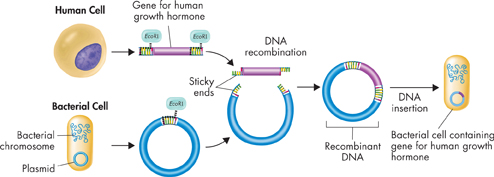
FIGURE 15–10 Plasmid DNA Transformation Scientists can insert a piece of DNA into a plasmid if both the plasmid and the target DNA have been cut by the same restriction enzymes to create sticky ends. With this method, bacteria can be used to produce human growth hormone. First, a human gene is inserted into bacterial DNA. Then, the new combination of genes is returned to a bacterial cell, which replicates the recombinant DNA over and over again. Infer Why might scientists want to copy the gene for human growth hormone?
dFigure 15–10 shows how bacteria can be transformed using recombinant plasmids. First, the DNA being used for transformation is joined to a plasmid. The plasmid DNA contains a signal for replication, helping to ensure that if the DNA does get inside a bacterial cell, it will be replicated. In addition, the plasmid also has a genetic marker, such as a gene for antibiotic resistance. A genetic marker is a gene that makes it possible to distinguish bacteria that carry the plasmid from those that don't. Using genetic markers, researchers can mix recombinant plasmids with a culture of bacteria, add enough DNA to transform just one cell in a million, and still locate that one cell. After transformation, the culture is treated with an antibiotic. Only those rare cells that have been transformed survive, because only they carry the resistance gene.
 In Your Notebook Write a summary of the process of plasmid DNA transformation.
In Your Notebook Write a summary of the process of plasmid DNA transformation.
Quick Lab
GUIDED INQUIRY
Inserting Genetic Markers
-
Write a random DNA sequence on a long strip of paper to represent an organism's genome.
-
Have your partner write a short DNA sequence on a short strip of paper to represent a marker gene.
-
Using the chart your teacher gives you, work with your partner to figure out how to insert the marker gene into the genome.
Apply Concepts Which restriction enzyme did you use? Why?
Use Models What kind of molecule did you and your partner develop?
Analyze and Conclude

Table of Contents
- Formulas and Equations
- Applying Formulas and Equations
- Mean, Median, and Mode
- Estimation
- Using Measurements in Calculations
- Effects of Measurement Errors
- Accuracy
- Precision
- Comparing Accuracy and Precision
- Significant Figures
- Calculating With Significant Figures
- Scientific Notation
- Calculating With Scientific Notation
- Dimensional Analysis
- Applying Dimensional Analysis




